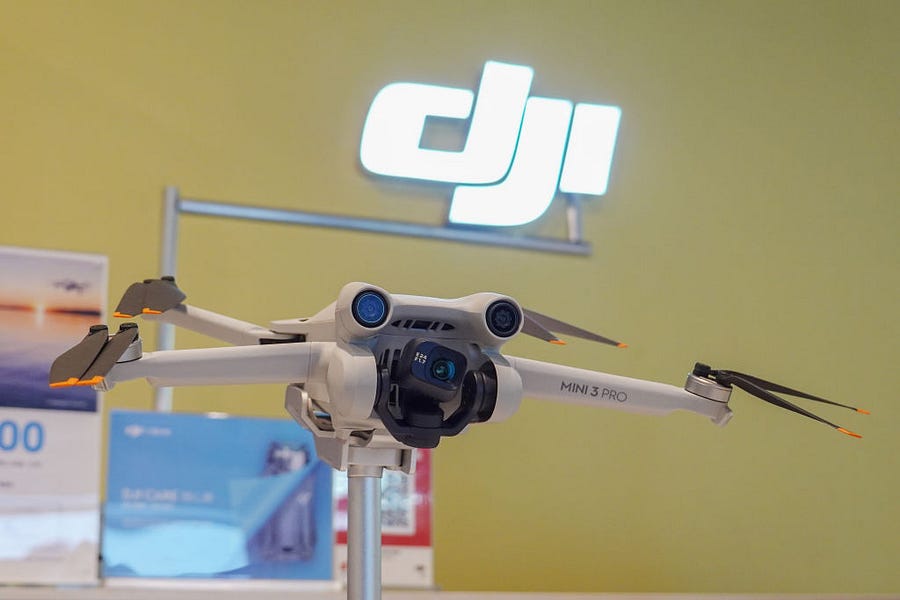Hello and happy Thursday.
So, I’ve got a drone on the way—the Skydio 2+—and I’m excited. Before saying more, in the name of transparency you should know that I’ve met the team at Skydio and I’m a fan of their products and of how they’re operating as a company, including its support for Ukraine. That said, their drones are objectively cool—just check out this video and you’ll see what I mean.

Now, if I’m honest, I must admit that my days of extreme sports, mountain climbing, and jumping trucks over exploding ditches are well behind me. So why, you may ask, am I geeking out about this new gear? Because drones are about more than cool YouTube videos, they are a growing part of how individuals engage the world around them, how industries operate and grow, and how nations go to war—and I want first-hand experience with this tech. But with these advancements also come some challenges. Before we get into all of that, though, let me give you some background.
When I say “drone,” I’m referring to remotely piloted or autonomous systems. While a drone can be land- or water-based, I’m going to focus on flying drones—formally called Unmanned Aerial Vehicles/ Systems (UAV/Ss).
While the underlying technology for drones has been steadily developing for decades, advances in artificial intelligence (AI) have greatly expanded their capabilities and they’re quickly becoming part of the mainstream of American life. For example, consumer drone sales in the United States exceeded $1.25 billion in 2020 and are projected to hit $100 billion. The drone services market, similarly, is expected to hit $63.6 billion in the next three years. But the real growth area is in “enterprise drones,” UAV/Ss for business.
The use of drones in agriculture, construction and mining, insurance, media and telecommunications, and law enforcement alone is expected to grow at a 66.8 percent compound annual growth rate (CAGR). Farmers use drones to monitor crops. Construction crews use them to inspect difficult-to-reach infrastructure. Insurance agents use them to assess hail damage or property values. Reporters and producers use drones to get that perfect shot. And police units use them to look for suspects or to document a crime scene. Heck, even Walmart is using drones for deliveries. These are just some of the proliferating uses of these technological marvels and soon we’ll wonder how we ever lived life without them.
Which brings me to my main point: The emerging ubiquity of drones means we must get serious about securing these systems now, and we’re already going to be digging out of a hole.
One company dominates the drone market—China’s Da-Jiang Innovations (DJI), which owns 54 percent of the global pie and as much as 80 percent of the U.S. market. More concretely, there may be as many as 684,000 DJI drones in the United States right now—including UAV/Ss being flown by the FBI, state and local law enforcement, and the owners of critical infrastructure. All of these drones are hoovering up tons of images and data.
Readers of this newsletter will be well-acquainted with the concerns around Chinese tech companies collecting American information and making it available to the government in Beijing, and these concerns certainly extend to DJI. In fact, what’s truly amazing is that DJI’s market dominance has persisted even after the United States has taken significant actions against the company.
The Pentagon has banned the use of DJI drones and there are rumors that the Biden administration may take further actions along these lines for the rest of the federal government. The company is also on the U.S. Entity List and an investment block list, which together mean that Americans cannot sell critical components or services to DJI or invest in the company. These actions are welcome, but DJI is still doing business in the United States and—in a bit of frustrating irony—another Chinese company, Autel, appears to be the primary beneficiary of what little market shifts that have occurred.
Okay, so what can be done to make things better? Here are five steps the United States should take on drones.
First, ban Chinese drones from the U.S. market. Putting DJI on the entity and investment ban lists was good, but if the underlying security concerns for these decisions are true—and they are—then why on earth would we allow them or another Chinese company to keep selling these devices to Americans? We know they have deep ties to the Chinese Communist Party (CCP) and that they even help the CCP to commit genocide. Such a ban doesn’t require the federal government to go home-to-home, grabbing citizen’s drones. It could be done by banning these companies from doing business in the United States and then allowing a gradual obsolescence as these drones are no longer serviced or updated. There are plenty of more trustworthy alternatives.
While this may seem drastic to some, it’s important to understand drones are not just a novelty—they are the precursor to future technologies that will be even more important. The companies that win the hobby and government drone market today will likely decisively shape the autonomous transportation and other related markets of tomorrow. This isn’t a “we have to ensure American competitiveness” argument either; it’s a “we cannot allow a hostile foreign government to control a core technology” argument, and we’re already woefully compromised.
There are several ways this ban could be enacted. Congressional action is always preferred but, under Section 232 of the Trade Expansion Act, the president can impose tariffs on or completely ban an import if it is considered a threat to U.S. national security. While I think a 232 action should be used sparingly, I believe it’s more than called for here. But because others are less sure than I am, I have a few other suggested actions that are less drastic but could still be helpful.
Second, enact the American Security Drone Act (ASDA). The ASDA bans federal procurement of drones (with some limited exceptions) manufactured by “a covered foreign entity,” including the People’s Republic of China. This bill text has been folded into both the House’s and Senate’s China competition bills (COMPETEs and USICA, respectively) which are being reconciled through Congress’ conference process. If Congress is serious about closing the doors to Chinese technological threats, the ASDA language should be a part of the final bill.
Closing the noose even tighter, third, 26 U.S. Code Section 848 should be amended to prohibit the use of Chinese drones by defense contractors. Banning the federal government from buying Chinese drones would be wise, but its protections would be limited if those contracting with the government continue to employ these systems because Beijing would still be gathering large volumes of important data. The Biden administration has employed a similar strategy on ransomware and other cyber threats, requiring all contractors to adopt specific practices and standards if they want to work with the federal government. As intended, these requirements are now proliferating through the private sector beyond government contracts. Updating Section 848 could similarly help disincentivize the use of Chinese drones throughout the American market.
Fourth, we need to fund the Coast Guard’s effort to “rip and replace” Chinese drones within their service. Like most of the U.S. government, the Coast Guard was attracted to DJI’s undeniable capabilities, low cost, and broad availability, and so it bought tons of these drones to aid with the service’s defense and homeland security missions. Now, however, the Coasties have found religion and they want to buy more secure alternatives, but Congress has yet to provide funding for the replacement drones. This is a no-brainer and would be less than a rounding error in the defense budget.
Finally, thinking less defensively and more about the future, we should fully fund the Blue sUAS program. Started in the Pentagon’s Defense Innovation Unite (DIU), the Blue sUAS program aims to rapidly vet and scale commercial drone technology for military applications—drastically reducing the “red tape” between trusted drone makers and the types of defense contracts that will eventually give rise to a more agile and aligned defense innovation base. Just $5 million is needed to fund the next stage of Blue sUAS and this capability will be very important for ensuring that, as we take defensive measures against Chinese drone companies, there are trusted alternatives ready and waiting to ensure the United States doesn’t lose ground when it comes to deploying and using unmanned systems for defense-related missions.
At the end of the day, what I really want you to know is that drones really are amazing tech. We’re on the cusp of massive improvements in efficiency and efficacy. Remotely piloted and autonomous systems will help save lives, protect infrastructure, and create new opportunities we haven’t even thought of yet. But to realize these promises, we must first secure these capabilities so that they can be developed, deployed, and enjoyed without compromising core aspects of our individual and collective security. Today I’ve tried to give five concrete ways for us to do exactly that.
Thanks for reading and I look forward to chatting again next week.
That’s it for this edition of The Current. Be sure to comment on this post and to share this newsletter with your family, friends, and followers. You can also follow me on Twitter (@KlonKitchen). Thanks for taking the time and I’ll see you next week!







Please note that we at The Dispatch hold ourselves, our work, and our commenters to a higher standard than other places on the internet. We welcome comments that foster genuine debate or discussion—including comments critical of us or our work—but responses that include ad hominem attacks on fellow Dispatch members or are intended to stoke fear and anger may be moderated.
With your membership, you only have the ability to comment on The Morning Dispatch articles. Consider upgrading to join the conversation everywhere.